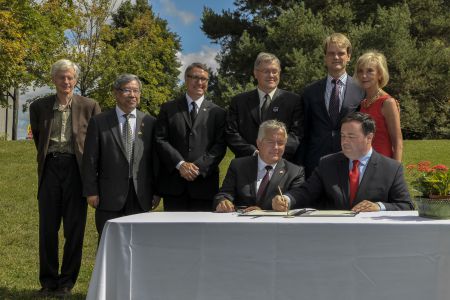The leader of a group receiving $1.5 million in federal funds to build a monument to victims of communism says Canada's Prime Minister and Minister for Multiculturalism have been part of the project from the start – a role uncommon for politicians in the creation of public monuments.
Toronto-based Tribute to Liberty has been fundraising for the monument since 2008, but had only raised $1 million of its $4 million target when it was given a Citizenship and Immigration Canada grant in August. The monument’s design will be decided through a competition, but the National Capital Commission has already granted it a plot in Ottawa between the Supreme Court and Library and Archives Canada. It is expected to be completed by the end of 2014.
“True inspiration comes directly from the PM,” Tribute to Liberty Chair Ludwik Klimkowski told the Toronto Media Co-op in a recent phone interview. “It was Stephen Harper’s idea of recognizing the contribution of people who came from communist countries.”
Klimkowski also said Tribute to Liberty “has its beginnings in 2008 when [Multiculturalism Minister] Jason Kenney was visiting a memorial erected by another group,” but declined to answer further questions about the politicians’ histories with the organization.
“This is not a Conservative Party project,” said Klimkowski. “This is meant to create one unified site of commemoration where we can learn from each other’s experiences and come to a healing place. [It’s a] representation of the Canadian mosaic of ethnic groups and a representation of the safe harbour Canada gave us.”
Tonya Davidson, an assistant professor of sociology at Ryerson University, has studied monuments in Ottawa extensively. She says it’s very unusual for monuments to originate from government; typically, they are devised by special interest groups and brought to a body such as the National Capital Commission for approval and support.
“The majority of monuments in Ottawa weren't the ideas of people at the government level,” she said in a September phone interview. “They respond to citizens’ proposals, and will decide if they want to donate land or money.”
According to Davidson, it is also rare for the government to fund monuments in the capital region. More often, it assists by providing plots of land through the NCC. She said the Peacekeeping Monument and the National War Memorial, which were completed in 1992 and 1939 respectively, were two notable exceptions which did receive taxpayer cash.
Outside of Ottawa, the government has provided financial support for several smaller memorial projects through CIC’s Community Historical Recognition Program, which has granted $13.5 million toward 68 cultural community projects over the past five years. Citizenship and Immigration spokesperson Remi Lariviere told the TMC that CIC also funded a monument to the Italian-Canadian internment history which appears at Toronto’s Columbus Centre. According to government disclosure statements, the Centre received $172,025 in 2012 and $916,827 in 2010.
Not surprisingly, the government’s support of Tribute to Liberty has drawn criticism from the Communist Party of Canada. The Party released a statement on Sept. 3 saying it finds the concept itself offensive, but also believes it is out of step with National Capital Commission guidelines for memorial content.
According to those guidelines, the NCC “recognizes the role of commemorations in achieving its mandate of building pride and unity among Canadians.”
The Communist Party statement says the monument will divide Canadians, not unify them, and noted that the number of victims includes “Soviet citizens who perished...during World War II...as allies of Canada.”
“The true underlying goal of this campaign is intended to intimidate and isolate progressive parties and movements, and to limit the free expression of ideas,” it said. The Party called the monument a throwback to the “red-baiting” tactics of the Cold War era.
“Such policies had a terrible chilling effect on public discourse and sharply curtailed the freedom of expression and associated democratic and trade union rights of all Canadians.”
Davidson, however, believes the monument falls in line with Canada’s other memorials to war history, observing that people from communist countries have long been barred from laying wreaths at the National War Memorial.
“People can critique it, but it does open up a useful and productive space for Canadians to mourn and commemorate the victims of communist violence,” she said. Davidson identified Ottawa’s Canadian Tribute to Human Rights monument as a possible alternative for such commemoration.
“[The proposed project is] not a monument to victims of an economic system of production, it’s a monument to people who are violently oppressed,” she said. “But it’s also necessary to think about how workers in our capitalist system are recognized in our built environment.
“The impulse is to counter this with a monument to victims of capitalism – but I don’t think they are mutually exclusive.”

